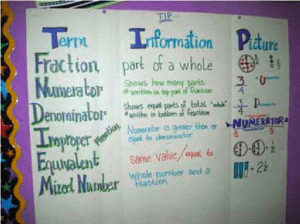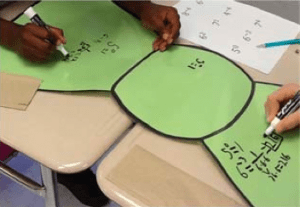This post is part of an ongoing series entitled “Wot-I-Got”. This series acts as a way for me to share Wot-I-Got out of a book or presentation and whet your appetite for enquiry. It also forces me to finish books that I start, then to review and summarise my conference notes!
This morning I woke before my alarm at 4:43am (Australian Eastern Standards Time) eager to jump into the ASCD webinar on Learning in the Fast Lane, with Suzy Pepper Rollins. Here’s some things that Suzy suggested could be done in classrooms and some of the ideas that her techniques sparked in my mind.
[update: My summary of the complete book is now available here]
Standards Walls and TIPS: Suzy suggested using Standards Walls. A standards wall is a poster or space on the wall to outline all of the learning goals for a class. But it isn’t just an A4 printout. It’s a big colourful poster that’s constantly evolving and edited by students. It’s acts as a reference for you to say “this is what we learnt last week, and this is what we’ll focus on today” and it provides a context for each lesson, building connections between the numerous concepts in a course. They also provide a framework for assessment and feedback by ensuring that both are in line with the learning goals.
TIPS: Based on the fact that it takes the average student 6 times to learn a word, Suzy suggests a chart with three columns: Term, Information, Picture to help students learn new words. This is better than just a vocab chart because “there’s a 35% increase in retention of words if there’s a picture”. Again, this can be an evolving chart that’s stuck on the wall and acts as a reference for students as you move through content.
An idea sparked: I thought that instead of just adding new terms to the TIP as you introduce them in class you could award prizes or rewards to students who interject your teaching with “TIP” when you use a new term that they haven’t heard before. A teacher could deliberately place certain new terms throughout the lesson and introduce the concept with something like “today you will hear 5 new terms, prizes for anyone who shouts ‘TIP’ first when I say each term for the first time”.
Scaffolding for Rigor: Scaffolding is, in Suzy’s words “plugging holes in the boat whilst moving forward”. The basic idea is that learning today depends on learning in the past, and one of the biggest challenges that students and teachers face when covering new content is the fact that they don’t have the prior knowledge required. “Scaffolding” refers to asking yourself prior to the class “My students could master this concept if only they knew…” then establishing ways to ‘scaffold’ learning by trying to plug these knowledge holes in the lesson. Scaffolding devices that were suggested are bookmarks (students make bookmarks with times tables or the like), posters on the wall, sticky notes and one really original example was a number line posted the ceiling! I must admit, I would have loved hear about more scaffolding devices for Math particularly and, unfortunately, the webinar didn’t have time to get to my question of “How do we scaffold for holes that are really big?” eg: the student still can’t do algebra!
Success Starters: Suzy mentioned that in the book How the Brain Learns Mathematics by David Souza, David suggests that students remember what’s covered mostly in the first few minutes and in the last few minutes of a class. The idea of a “Success Starter” is it’s like a warmup but it’s content focused to take advantage of those vital learning minutes at the start of a class. Students can never take in all of the information that they encounter throughout the day, so they are constantly selectively deleting information and (consciously or unconsciously) asking themselves questions like “what’s this got to do with me?” and “will I have a good chance of being successful at learning this?”. Some examples of Success Starters are doing a survey that’s related to the class content or getting students to do an “Alphabetic Brainstorm, essentially trying to think of something that starts with A, B, C, D, etc (you can restrict the range to keep the task shorter) that’s related to one of the concepts that you’ll be covering during the day. This also links to Suzy’s suggestion that one of the biggest determinants of success in class is prior knowledge. So alphabet brainstorms really tap into that prior knowledge and share it around with the wider class.
An idea sparked: I thought that a good success starter could be to have different tasks or questions on different tables, and get students to walk around the room and look at the questions and decide to sit at the table with the question that they’d most like to address, or the piece of information that they would most like to learn. Alternatively, you could run a pop quiz 5 minutes into the lesson, but don’t call it a pop quiz, call it a “peep quiz” , and the students actually have the answers to the quiz sitting on their tables when they walk into the room and they have 5 minutes to peep the answers before they do the quiz. This could be used well in a summary class where the remainder of the class could be used to focus on points that the students struggled with in the peep quiz.
See what they’re doing minute-by-minute, Formative Assessment: Many readers will be familiar with formative assesment so I’ll just point out the techniques that were suggested in the webinar:
 Bow Tie: Get work on a task together on a big ‘bow tie’
Bow Tie: Get work on a task together on a big ‘bow tie’
where the centre acts as a
space for consensus answers (see pic)- Sorts: Sorts are getting students to sort information (often presented on small cards) to promote discussion about categories and aid comprehension
- Cubes: Teachers can make ‘cubes’ that have questions (or components of questions) on them and students can roll the cubes to introduce see which question to do next (or to make up a question. Eg: multiply the number on the first cube by the no on the second)
An Idea sparked: I’ve been thinking about employing Flubaroo in the classroom for a while but I had 2 ideas of how to make this a bit smoother.
Firstly: Get students to only enter their answers into the google docs solutions page at the end of the test, give them 3 mins or so to do this. This has multiple benefits
- students won’t get distracted by their computer during the test
- their writing will have to be tidy so that they can see what they did
- this forces them to look back over their working and answers
- It would help to avoid them googling answers (due to the limited time)
- The teacher could sit at the back of the class and watch screens for this short period of time
Secondly: Double tests in one class! Test students once, and aportion some level of value to the first test, then you use the feedback from that first test instantly motivate them to learn to study hard and fast for a second test (may be better for tests for which marks aren’t recorded as don’t want to put too much pressure on students). Furthremore, the info from test 1 could allow a teacher to match up students that got the answer right with students who could do with a little help (for the qs where there is a balance of correct and incorrect answers). For the Qs where lots of students need help, a teacher could go over the process on the board for the whole class’ benefit.
Self-Efficacy Development: It was suggested that a teacher should consider the following when trying to build self efficacy among students
- level of difficulty of the task
- value of task (perceived and real)
- Incorporate choices and social interactions into learning
- compelling openers that build success (see “Success Starters” above)
- safe for mistakes (try to foster a culture of sharing in the classroom)
- short term goals (keep learning goals relevant and today)
- ongoing, quick feedback (see “See what they’re doing” above)
Building self-efficacy among students remains one of the biggest and most important challenges for teachers. Unfortunately, with the 4 or so minutes that we had a the end of the webinar to cover this point we weren’t able to go into that much depth.
Summary: I found the webinar extremely insightful and Suzy’s enthusiasm and obvious experiences of success were really inspiring. I found the learning in the fast lane approach to be a useful collection of practical suggestions for the classroom and particularly like how teachers can pick and choose which elements of the approach to implement and which to leave out. It isn’t an “all or nothing” model.
A great summary of the the collection of articles that form the pedagogical basis for the Learning in the Fast Lane model can be found here.
A podcast with Suzy Pepper Rollins can be found here.

 Bow Tie: Get work on a task together on a big ‘bow tie’
Bow Tie: Get work on a task together on a big ‘bow tie’